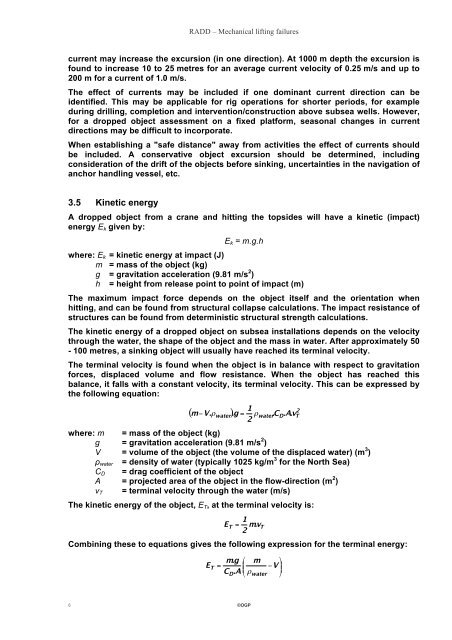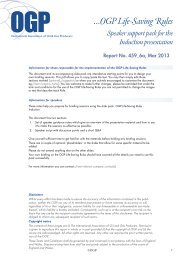Mechanical lifting failures - OGP
Mechanical lifting failures - OGP
Mechanical lifting failures - OGP
Create successful ePaper yourself
Turn your PDF publications into a flip-book with our unique Google optimized e-Paper software.
RADD – <strong>Mechanical</strong> <strong>lifting</strong> <strong>failures</strong><br />
current may increase the excursion (in one direction). At 1000 m depth the excursion is<br />
found to increase 10 to 25 metres for an average current velocity of 0.25 m/s and up to<br />
200 m for a current of 1.0 m/s.<br />
The effect of currents may be included if one dominant current direction can be<br />
identified. This may be applicable for rig operations for shorter periods, for example<br />
during drilling, completion and intervention/construction above subsea wells. However,<br />
for a dropped object assessment on a fixed platform, seasonal changes in current<br />
directions may be difficult to incorporate.<br />
When establishing a "safe distance" away from activities the effect of currents should<br />
be included. A conservative object excursion should be determined, including<br />
consideration of the drift of the objects before sinking, uncertainties in the navigation of<br />
anchor handling vessel, etc.<br />
3.5 Kinetic energy<br />
A dropped object from a crane and hitting the topsides will have a kinetic (impact)<br />
energy E k given by:<br />
E k = m.g.h<br />
where: E k = kinetic energy at impact (J)<br />
m = mass of the object (kg)<br />
g = gravitation acceleration (9.81 m/s 2 )<br />
h = height from release point to point of impact (m)<br />
The maximum impact force depends on the object itself and the orientation when<br />
hitting, and can be found from structural collapse calculations. The impact resistance of<br />
structures can be found from deterministic structural strength calculations.<br />
The kinetic energy of a dropped object on subsea installations depends on the velocity<br />
through the water, the shape of the object and the mass in water. After approximately 50<br />
- 100 metres, a sinking object will usually have reached its terminal velocity.<br />
The terminal velocity is found when the object is in balance with respect to gravitation<br />
forces, displaced volume and flow resistance. When the object has reached this<br />
balance, it falls with a constant velocity, its terminal velocity. This can be expressed by<br />
the following equation:<br />
where: m = mass of the object (kg)<br />
g = gravitation acceleration (9.81 m/s 2 )<br />
V = volume of the object (the volume of the displaced water) (m 3 )<br />
ρ water = density of water (typically 1025 kg/m 3 for the North Sea)<br />
C D = drag coefficient of the object<br />
A = projected area of the object in the flow-direction (m 2 )<br />
v T = terminal velocity through the water (m/s)<br />
The kinetic energy of the object, E T , at the terminal velocity is:<br />
Combining these to equations gives the following expression for the terminal energy:<br />
6<br />
©<strong>OGP</strong>

















